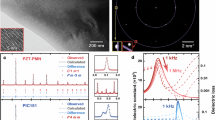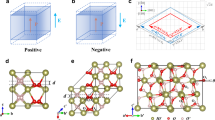Abstract
Piezoelectric materials directly convert between electrical and mechanical energies. They are used as transducers in applications such as nano-positioning and ultrasound imaging. Improving the properties of these devices requires piezoelectric materials capable of delivering a large longitudinal strain on the application of an electric field. A large longitudinal strain of more than 1% is generally anticipated in suitably oriented single crystals of specific compositions of ferroelectric materials1. Polycrystalline piezoceramics typically show a longitudinal strain of approximately 0.2–0.4%. We demonstrate that when the thickness of a polycrystalline piezoceramic is reduced to such an extent that a large fraction of the grains are in the triaxial–biaxal crossover regime, the ___domain-switching fraction increases considerably. If the positive and the negative surfaces of the piezoceramic respond to electric fields symmetrically, as in the classical PbZrxTixO3, a longitudinal strain of approximately 1% can be achieved in a 0.2 mm disc of the morphotropic phase boundary composition (a 300% increase from a thickness of 0.7 mm). We show that oxygen vacancies in piezoceramics cause asymmetrical switching at the positive and negative surfaces, which causes thin piezoceramics to bend. We expect these findings will encourage further engineering of these mechanisms across different piezoelectric material systems, opening new applications for electromechanical actuation.
This is a preview of subscription content, access via your institution
Access options
Access Nature and 54 other Nature Portfolio journals
Get Nature+, our best-value online-access subscription
27,99 € / 30 days
cancel any time
Subscribe to this journal
Receive 51 print issues and online access
199,00 € per year
only 3,90 € per issue
Buy this article
- Purchase on SpringerLink
- Instant access to full article PDF
Prices may be subject to local taxes which are calculated during checkout



Similar content being viewed by others
Data availability
The authors declare that the data supporting the findings of this study are available within the paper and its Supplementary Information files.
References
Park, S.-E. & Shrout, T. R. Ultrahigh strain and piezoelectric behavior in relaxor based ferroelectric single crystals. J. Appl. Phys. 82, 1804 (1997).
Du, X., Belegundu, U. & Uchino, K. Crystal orientation dependence of piezoelectric properties in lead zirconate titanate: theoretical expectation for thin films. Jpn. J. Appl. Phys. 36, 5580–5587 (1997).
Li, J. Y., Rogan, R. C., Üstündag, E. & Bhattacharya, K. Domain switching in polycrystalline ferroelectric ceramics. Nat. Mater. 4, 776–781 (2005).
Hall, D. A., Steuwer, A., Cherdhirunkorn, B., Mori, T. & Withers, P. J. Analysis of elastic strain and crystallographic texture in poled rhombohedral PZT ceramics. Acta Mater. 54, 3075 (2006).
Jones, J. L., Hoffman, M. & Bowman, K. J. Saturated ___domain switching textures and strains in ferroelastic ceramics. J. Appl. Phys. 98, 024115 (2005).
Oddershede, J., Hossain, M. J. & Daniels, J. E. Maximising electro-mechanical response by minimising grain-scale strain heterogeneity in phase-change actuator ceramic. Appl. Phys. Lett. 109, 092901 (2016).
Hao, J., Li, W., Zhai, J. & Chen, H. Progress in high-strain perovskite piezoelectric ceramics. Mater. Sci. Eng.: R: Rep. 135, 1–57 (2019).
Huang Fu, G. et al. Giant electric field–induced strain in lead-free piezoceramics. Science 378, 1125–1130 (2022).
Lai, L. et al. Giant electrostrain in leadfree textured piezoceramics by defect dipole design. Adv. Mater. 35, 2300519 (2023).
Wang, B., Huangfu, G., Zheng, Z. & Guo, Y. Giant electric field-induced strain with high temperature-stability in textured KNN-based piezoceramics for actuator applications. Adv. Funct. Mater. 33, 221464 (2023).
Feng, W. et al. Heterostrain-enabled ultrahigh electrostrain in lead-free piezoelectric. Nat. Commun. 13, 5086 (2022).
Luo, H. et al. Achieving giant electrostrain of above 1% in (Bi,Na)TiO3-based lead-free piezoelectrics via introducing oxygen-defect composition. Sci. Adv. 9, 7078 (2023).
Jia, Y. et al. Giant electro-induced strain in lead-free relaxor ferroelectrics via defect engineering. J. Eur. Ceram. Soc. 43, 947 (2023).
Li, W. et al. Giant electro-strain nearly 1% in BiFeO3-based lead-free piezoelectric ceramics through coupling morphotropic phase boundary with defect engineering. Mater. Today Chem. 26, 101237 (2022).
Narayan, B. et al. Electrostrain in excess of 1% in polycrystalline piezoelectrics. Nat. Mater. 17, 427 (2018).
Adhikary, G. D., Singh, D. N., Tina, G. A., Muleta, G. J. & Ranjan, R. Ultrahigh electrostrain >1% in lead-free piezoceramics: role of disk dimension. J. Appl. Phys. 134, 054101 (2023).
He, X. et al. Ultra-large electromechanical deformation in lead-free piezoceramics at reduced thickness. Mater. Horiz. 11, 1079–1087 (2024).
Wang, J., Wang, B., Zhang, H., Zhang, S. & Guo, Y. Ultrahigh electrobending deformation in lead-free piezoelectric ceramics via defect concentration gradient design. Adv. Mater. 36, e2404682 (2024).
Paterson, A. R. et al. Relaxor-ferroelectric transitions: sodium bismuth titanate derivatives. MRS Bull. 43, 600–606 (2018).
Holgado, J. P., Munuera, G., Espinós, J. P. & González-Elipe, A. R. XPS study of oxidation processes of CeOx defective layers. Appl. Surf. Sci. 158, 164–171 (2000).
Hanzig, J. et al. Migration-induced field-stabilized polar phase in strontium titanate single crystals at room temperature. Phys. Rev. B 88, 024104 (2013).
Khanbabaee, B. et al. Large piezoelectricity in electric-field modified single crystals of SrTiO3. Appl. Phys. Lett. 109, 222901 (2016).
He, L. & Vandebilt, D. First-principles study of oxygen-vacancy pinning of ___domain walls in PbTiO3. Phys. Rev. B 68, 134103 (2003).
Kitanaka, Y., Noguchi, Y. & Miyayama, M. Oxygen-vacancy-induced 90°-___domain clamping in ferroelectric Bi4Ti3O12 single crystals. Phys. Rev. B 81, 094114 (2010).
Pramanick, A., Damjanvic, D., Daniels, J. E., Nino, J. C. & Jones, J. L. Origins of electromechanical coupling in polycrystalline ferroelectrics during subcoercive electric loading. J. Am. Ceram. Soc. 94, 293 (2011).
Vaughan, G. B. et al. ID15A at the ESRF–a beamline for high speed operando X-ray diffraction, diffraction tomography and total scattering. J. Synchrotron Radiat. 27, 515 (2020).
Raimondi, P. et al. The extremely brilliant source storage ring of the European Synchrotron Radiation Facility. Commun. Phys. 6, 82 (2023).
Ashiotis, G. et al. The fast azimuthal integration Python library: pyFAI. J. Appl. Crystallogr. 48, 510 (2015).
Acknowledgements
R.R. and G.D.A. acknowledge the Science and Engineering Research Board for financial assistance (Grant No. CRG/2021/000134). R.R. gratefully acknowledges D. Damjanovic for fruitful discussion. D.N.S. gratefully acknowledges the Dr. D. S. Kothari fellowship of the University Grant Commission (UGC), India (Award No. F.4-2/2006 (BSR)/PH/20–21/0100). M. gratefully acknowledges UGC, India for awarding the JRF and SRF fellowships (Ref No. 201610120431). The European Synchrotron Radiation Facility is acknowledged for provision of beamtime under proposal number MA-6069 (https://doi.org/10.15151/ESRF-ES-1465100316).
Author information
Authors and Affiliations
Contributions
G.D.A. and R.R. led the overall work, planned and executed most of the experiments (in situ laboratory XRD under a field, XPS, S–E and P–E measurements), and analysed the data. L.G. and J.D. imaged the disc-bending. J.D. and H.L. performed the FEM modelling. R.R., G.D.A. and J.D. discussed the overall results and participated in writing the manuscript. G.D.A., A.A., G.J.M., M., R.P.S., D.N.S. and G.A.T. prepared piezoelectric specimens with different compositions and measured their physical properties. S.C. and J.D. planned the depth scanning measurements using high-energy synchrotron X-rays, and S.C., J. D. and R.R. conducted the experiments at the European Synchrotron Radiation Facility.
Corresponding author
Ethics declarations
Competing interests
J.D. is a director of Citrus Pty Ltd, which produces the system for in situ diffraction and imaging measurements under an applied electric field.
Peer review
Peer review information
Nature thanks Nan Zhang and the other, anonymous, reviewer(s) for their contribution to the peer review of this work. Peer reviewer reports are available.
Additional information
Publisher’s note Springer Nature remains neutral with regard to jurisdictional claims in published maps and institutional affiliations.
Supplementary information
Supplementary Information
Supplementary Table 1 and Figs. 1–26.
Supplementary Video 1
Bending video of BaTiO3.
Supplementary Video 2
Bending of BFPT-La.
Supplementary Video 3
Bending of KNSN3.
Supplementary Video 4
Bending of NBT-10BT.
Supplementary Video 5
Bending of PZT52VA.
Rights and permissions
Springer Nature or its licensor (e.g. a society or other partner) holds exclusive rights to this article under a publishing agreement with the author(s) or other rightsholder(s); author self-archiving of the accepted manuscript version of this article is solely governed by the terms of such publishing agreement and applicable law.
About this article
Cite this article
Das Adhikary, G., Adukkadan, A., Muleta, G.J. et al. Longitudinal strain enhancement and bending deformations in piezoceramics. Nature 637, 333–338 (2025). https://doi.org/10.1038/s41586-024-08292-1
Received:
Accepted:
Published:
Issue Date:
DOI: https://doi.org/10.1038/s41586-024-08292-1
This article is cited by
-
High electrostrain due to a chemopiezoelectric effect
Nature Materials (2025)



